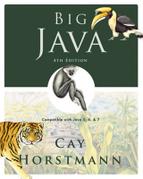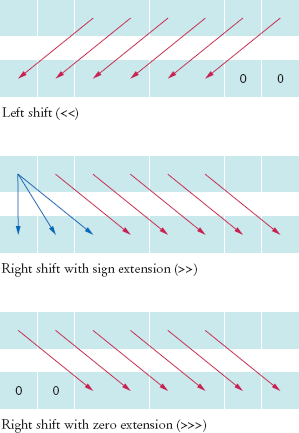- Copyright
- PREFACE
- 1. Introduction
- 2. Using Objects
- 2.1. Types
- 2.2. Variables
- 2.3. The Assignment Operator
- 2.4. Objects, Classes, and Methods
- 2.5. Method Parameters and Return Values
- 2.6. Constructing Objects
- 2.7. Accessor and Mutator Methods
- 2.8. The API Documentation
- 2.9. Implementing a Test Program
- 2.10. Object References
- 2.11. Graphical Applications and Frame Windows
- 2.12. Drawing on a Component
- 2.13. Ellipses, Lines, Text, and Color
- 2.13.1. Ellipses and Circles
- 2.13.2. Lines
- 2.13.3. Drawing Text
- 2.13.4. Colors
- 2.13.5. Summary of Learning Objectives
- 2.13.6. Classes, Objects, and Methods Introduced in this Chapter
- 2.13.7. Media Resources
- 2.13.8. Review Exercises
- 2.13.9. Programming Exercises
- 2.13.10. Programming Projects
- 2.13.11. Answers to Self-Check Questions
- 3. Implementing Classes
- 4. Fundamental Data Types
- 5. Decisions
- 6. Iteration
- 7. Arrays and Array Lists
- 7.1. Arrays
- 7.2. Array Lists
- 7.3. Wrappers and Auto-boxing
- 7.4. The Enhanced for Loop
- 7.5. Partially Filled Arrays
- 7.6. Common Array Algorithms
- 7.6.1. Filling
- 7.6.2. Computing Sum and Average Values
- 7.6.3. Counting Matches
- 7.6.4. Finding the Maximum or Minimum
- 7.6.5. Searching for a Value
- 7.6.6. Locating the Position of an Element
- 7.6.7. Removing an Element
- 7.6.8. Inserting an Element
- 7.6.9. Copying and Growing Arrays
- 7.6.10. Printing Element Separators
- 7.7. Regression Testing
- 7.8. Two-Dimensional Arrays
- 8. Designing Classes
- 9. Interfaces and Polymorphism
- 9.1. Using Interfaces for Algorithm Reuse
- 9.2. Converting Between Class and Interface Types
- 9.3. Polymorphism
- 9.4. Using Interfaces for Callbacks
- 9.5. Inner Classes
- 9.6. Mock Objects
- 9.7. Events, Event Sources, and Event Listeners
- 9.8. Using Inner Classes for Listeners
- 9.9. Building Applications with Buttons
- 9.10. Processing Timer Events
- 9.11. Mouse Events
- 10. Inheritance
- 11. Input/Output and Exception Handling
- 12. Object-Oriented Design
- 12.1. The Software Life Cycle
- 12.2. Discovering Classes
- 12.3. Relationships Between Classes
- 12.4. Case Study: Printing an Invoice
- 12.5. Case Study: An Automatic Teller Machine
- 12.5.1. Requirements
- 12.5.2. CRC Cards
- 12.5.3. UML Diagrams
- 12.5.4. Method Documentation
- 12.5.5. Implementation
- 12.5.6. Summary of Learning Objectives
- 12.5.7. Media Resources
- 12.5.8. Review Exercises
- 12.5.9. Programming Exercises
- 12.5.10. Programming Projects
- 12.5.11. Answers to Self-Check Questions
- 13. Recursion
- 14. Sorting and Searching
- 15. An Introduction to Data Structures
- 16. Advanced Data Structures
- 17. Generic Programming
- 18. Graphical User Interfaces
- 19. Streams and Binary Input/Output
- 20. Multithreading
- 21. Internet Networking
- 22. Relational Databases
- 23. XML
- 23.1. XML Tags and Documents
- 23.2. Parsing XML Documents
- 23.3. Creating XML Documents
- 23.4. Validating XML Documents
- 23.4.1. Document Type Definitions
- 23.4.2. Specifying a DTD in an XML Document
- 23.4.3. Parsing and Validation
- 23.4.4. Summary of Learning Objectives
- 23.4.5. Media Resources
- 23.4.6. Classes, Objects, and Methods Introduced in this Chapter
- 23.4.7. Review Exercises
- 23.4.8. Programming Exercises
- 23.4.9. Programming Projects
- 23.4.10. Answers to Self-Check Questions
- 24. Web Applications
- A. The Basic Latin and Latin-1 Subsets of Unicode
- B. Java Operator Summary
- C. Java Reserved Word Summary
- D. The Java Library
- D.1. Package java.applet
- D.2. Package java.awt
- D.2.1. Class java.awt.BorderLayout
- D.2.2. Class java.awt.Color
- D.2.3. Class java.awt.Component
- D.2.4. Class java.awt.Container
- D.2.5. Class java.awt.Dimension
- D.2.6. Class java.awt.FlowLayout
- D.2.7. Class java.awt.Font
- D.2.8. Class java.awt.Frame
- D.2.9. Class java.awt.Graphics
- D.2.10. Class java.awt.Graphics2D
- D.2.11. Class java.awt.GridLayout
- D.2.12. Class java.awt.Rectangle
- D.2.13. Interface java.awt.Shape
- D.3. Package java.awt.event
- D.4. Package java.awt.geom
- D.5. Package java.io
- D.5.1. Class java.io.EOFException
- D.5.2. Class java.io.File
- D.5.3. Class java.io.FileInputStream
- D.5.4. Class java.io.FileNotFoundException
- D.5.5. Class java.io.FileOutputStream
- D.5.6. Class java.io.InputStream
- D.5.7. Class java.io.InputStreamReader
- D.5.8. Class java.io.IOException
- D.5.9. Class java.io.ObjectInputStream
- D.5.10. Class java.io.ObjectOutputStream
- D.5.11. Class java.io.OutputStream
- D.5.12. Class java.io.PrintStream/Class java.io.PrintWriter
- D.5.13. Class java.io.RandomAccessFile
- D.5.14. Interface java.io.Serializable
- D.6. Package java.lang
- D.6.1. Class java.lang.Boolean
- D.6.2. Class java.lang.Character
- D.6.3. Class java.lang.Class
- D.6.4. Interface java.lang.Cloneable
- D.6.5. Class java.lang.CloneNotSupportedException
- D.6.6. Interface java.lang.Comparable<T>
- D.6.7. Class java.lang.Double
- D.6.8. Class java.lang.Error
- D.6.9. Class java.lang.IllegalArgumentException
- D.6.10. Class java.lang.IllegalStateException
- D.6.11. Class java.lang.Integer
- D.6.12. Class java.lang.InterruptedException
- D.6.13. Class java.lang.Math
- D.6.14. Class java.lang.NullPointerException
- D.6.15. Class java.lang.NumberFormatException
- D.6.16. Class java.lang.Object
- D.6.17. Interface java.lang.Runnable
- D.6.18. Class java.lang.RuntimeException
- D.6.19. Class java.lang.String
- D.6.20. Class java.lang.System
- D.6.21. Class java.lang.Thread
- D.6.22. Class java.lang.Throwable
- D.7. Package java.math
- D.8. Package java.net
- D.9. Package java.sql
- D.10. Package java.text
- D.11. Package java.util
- D.11.1. Class java.util.ArrayList<E>
- D.11.2. Class java.util.Arrays
- D.11.3. Class java.util.Calendar
- D.11.4. Interface java.util.Collection<E>
- D.11.5. Class java.util.Collections
- D.11.6. Interface java.util.Comparator<T>
- D.11.7. Class java.util.Date
- D.11.8. Class java.util.EventObject
- D.11.9. Class java.util.GregorianCalendar
- D.11.10. Class java.util.HashMap<K, V>
- D.11.11. Class java.util.HashSet<E>
- D.11.12. Class java.util.InputMismatchException
- D.11.13. Interface java.util.Iterator<E>
- D.11.14. Class java.util.LinkedHashMap<K, V>
- D.11.15. Class java.util.LinkedList<E>
- D.11.16. Interface java.util.List<E>
- D.11.17. Interface java.util.ListIterator<E>
- D.11.18. Interface java.util.Map<K, V>
- D.11.19. Class java.util.NoSuchElementException
- D.11.20. Class java.util.PriorityQueue<E>
- D.11.21. Class java.util.Properties
- D.11.22. Class java.util.Random
- D.11.23. Class java.util.Scanner
- D.11.24. Interface java.util.Set<E>
- D.11.25. Class java.util.TimeZone
- D.11.26. Class java.util.TreeMap<K, V>
- D.11.27. Class java.util.TreeSet<E>
- D.12. Package java.util.concurrent.locks
- D.13. Package java.util.logging
- D.14. Package javax.swing
- D.14.1. Class javax.swing.AbstractButton
- D.14.2. Class javax.swing.ButtonGroup
- D.14.3. Class javax.swing.ImageIcon
- D.14.4. Class javax.swing.JButton
- D.14.5. Class javax.swing.JCheckBox
- D.14.6. Class javax.swing.JComboBox
- D.14.7. Class javax.swing.JComponent
- D.14.8. Class javax.swing.JFileChooser
- D.14.9. Class javax.swing.JFrame
- D.14.10. Class javax.swing.JLabel
- D.14.11. Class javax.swing.JMenu
- D.14.12. Class javax.swing.JMenuBar
- D.14.13. Class javax.swing.JMenuItem
- D.14.14. Class javax.swing.JOptionPane
- D.14.15. Class javax.swing.JPanel
- D.14.16. Class javax.swing.JRadioButton
- D.14.17. Class javax.swing.JScrollPane
- D.14.18. Class javax.swing.JSlider
- D.14.19. Class javax.swing.JTextArea
- D.14.20. Class javax.swing.JTextField
- D.14.21. Class javax.swing.Timer
- D.15. Package javax.swing.border
- D.16. Package javax.swing.event
- D.17. Package javax.swing.text
- D.18. Package javax.xml.parsers
- D.19. Package javax.xml.xpath
- D.20. Package org.w3c.dom
- D.21. Package org.w3c.dom.ls
- E. Java Syntax Summary
- F. HTML Summary
- G. Tool Summary
- H. javadoc Summary
- I. Number Systems
- J. Bit and Shift Operations
- K. UML Summary
- L. Java Language Coding Guidelines
- GLOSSARY
- ILLUSTRATION CREDITS
There are four bit operations in Java: the unary negation (~) and the binary and (&), or (|), and exclusive or (^), often called xor.
Tables 1 and 2 show the truth tables for the bit operations in Java. When a bit operation is applied to integer values, the operation is carried out on corresponding bits.
For example, suppose we want to compute 46 & 13. First convert both values to binary. 46decimal = 101110binary (actually 00000000000000000000000000101110 as a 32-bit integer), and 13decimal = 1101binary. Now combine corresponding bits:
The answer is 1100binary = 12decimal.
You sometimes see the | operator being used to combine two bit patterns. For example, Font.BOLD is the value 1, Font.ITALIC is 2. The binary or combination Font.BOLD | Font.ITALIC has both the bold and the italic bit set:
Don't confuse the & and | bit operators with the && and || operators. The latter work only on boolean values, not on bits of numbers.
Besides the operations that work on individual bits, there are three shift operations that take the bit pattern of a number and shift it to the left or right by a given number of positions. There are three shift operations: shift left (<<), right shift with sign extension (>>), and right shift with zero extension (>>>).
The left shift moves all bits to the left, filling in zeroes in the least significant bits. Shifting to the left by n bits yields the same result as multiplication by 2n. The right shift with sign extension moves all bits to the right, propagating the sign bit. Therefore, the result is the same as integer division by 2n, both for positive and negative values. Finally, the right shift with zero extension moves all bits to the right, filling in zeroes in the most significant bits. (See Figure 1.)
Note that the right-hand-side value of the shift operators is reduced modulo 32 (for int values) or 64 (for long values) to determine the actual number of bits to shift.
For example, 1 << 35 is the same as 1 << 3. Actually shifting 1 by 35 bits to the left would make no sense—the result would be 0.
The expression
1 << n
yields a bit pattern in which the nth bit is set (where the 0 bit is the least significant bit).
To set the nth bit of a number, carry out the operation
x = x | 1 << n
To check whether the nth bit is set, execute the test
if ((x & 1 << n) != 0) ...
Note that the parentheses around the & are required—the & operator has a lower precedence than the relational operators.
-
No Comment

